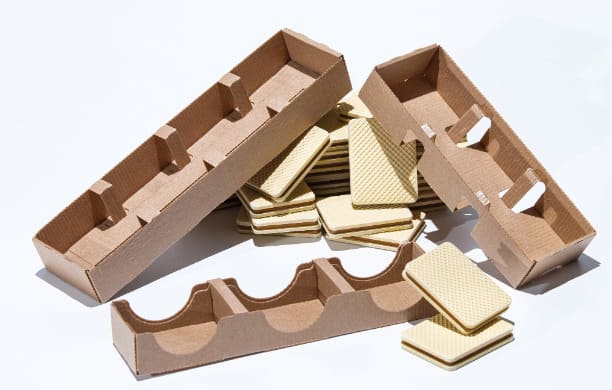Certain types of packaging protect products with literally every fibre of their being. Cardboard is one of them – and it comes with an extensive range of sturdy packaging options for consumer goods. To ensure that this cellulose-based material remains sustainable, it has to meet a multitude of requirements.
If you have ever picked up a six-pack of soda or beer from a retail shelf with two or three fingers, you have no doubt been startled by its weight. The cardboard package does a great job of holding the bottles securely in place. Strongly bonded, long fibres give this type of cardboard everything it needs to hold its shape.
Fibre materials such as cellulose, wood pulp and waste paper make up 95 percent of paperboard, which manufacturers bind with glue and structure in many different ways. The result is a range of different grammages – or weight per square metre – that can be used either as boxes, bottle sleeves or even moving boxes.
Made for recycling
With its exceptional resilience and use of natural raw materials, it would make little ecological sense not to reuse this high-performance packaging material multiple times. To produce recycled cardboard, the fibres are shredded and mixed with water to create a homogeneous pulp. After de-inking, the fibre mass is poured onto the screen of the cardboard machine for shaping.
It may sound like a straightforward process, but it isn’t. Only cardboard that has been largely untreated can be recycled efficiently. If cardboard has a PE or aluminium coating, for example, separation becomes complex – with poorer results than without the additional layers. In baked goods, for example, a thin layer of PE is often applied to the packaging material to prevent unsightly grease residues.
There are simple, streamlined packaging solutions, on the other hand, that not only offer recycling advantages but also comply with the PPWR. The EU regulation promotes the production and use of packaging made from single materials – as they are more likely to help meet ambitious recycling targets. According to the PPWR, 70 per cent of all packaging waste in the European single market needs to be recycled by 2030.
The ambitious PPWR is bearing fruit. A positive trend is reflected across Europe, as indicated by a Pro Carton survey. With a recycling rate of 83.2 per cent, fibre-based packaging materials have established themselves as frontrunners in the recycling sector.
Flawless recycling material
Efficient recycling, however, hinges on cleanliness and sorting. Cardboard shouldn’t contain any food residues, as these make recycling more difficult. Consumers have a responsibility to ensure that only cardboard packaging that doesn’t prevent recycling is sent into the recycling stream. At least in the case of recycled cardboard, German legislation prevents such contamination by prohibiting direct contact between food and recycled materials.
This precautionary measure is indispensable because both residues of oil-based printing inks (known as MOSH/MOAH compounds) and certain process chemicals can cause potentially dangerous contamination. For this reason, food in recycled cardboard packaging is always additionally protected by a flowpack pouch or other primary packaging.
Where food comes into direct contact with cardboard – such as biscuits and cardboard trays – pure virgin fibre packaging is used, although it sometimes has the aforementioned PE coating. More environmentally friendly alternatives such as dispersion barrier coatings do exist and have a significantly lower impact on fibre recovery. Due to ongoing development, however, this lacquer has not yet established itself on the market. Water-based inks, which are predominantly used in Europe instead of oil-based inks, can further increase the safety of such packaging.
Eco-friendliness at any price?
With a view to more environmentally friendly practices, it is still worth looking beyond wood fibre-based solutions. Cardboard made from grass or cup plant (Silphium perfoliatum), a plant from the daisy family, offers viable options. Consumer goods manufacturers are already using them for various marketing purposes – albeit to a limited extent due to high prices and sensory restrictions. Packaging machine manufacturers play a pivotal role here, as they can offer advice on factors such as machine compatibility.
A complete move away from virgin fibres in cardboard packaging seems unlikely at present – and is not absolutely necessary as long as the wood used comes from sustainably managed forests. Cardboard is very likely to retain its place in the packaging mix as long as manufacturers also consider the requirements for simple, material-reduced cardboard solutions.
In addition to the requirements of the EU Packaging and Packaging Waste Regulation (PPWR), food manufacturers need to take into account factors such as product protection, machine compatibility, environmental friendliness, cost-effectiveness and consumer expectations. Schubert has significantly expanded its consulting services in recent years and supports manufacturers in meeting the requirements of the PPWR. ‘Packaging Competence Centre’ is the name of the company’s comprehensive service that includes consulting, packaging development, packaging optimisation, a state-of-the-art testing centre as well as partnerships with packaging manufacturers.





